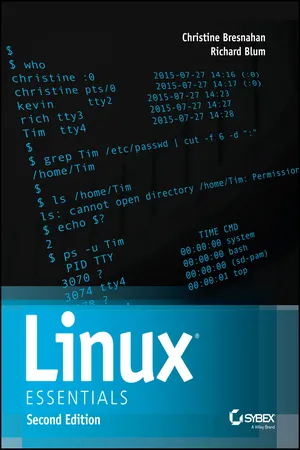
- English
- ePUB (mobile friendly)
- Available on iOS & Android
Linux Essentials
About this book
Learn Linux, and take your career to the next level!
Linux Essentials, 2 nd Edition provides a solid foundation of knowledge for anyone considering a career in information technology, for anyone new to the Linux operating system, and for anyone who is preparing to sit for the Linux Essentials Exam. Through this engaging resource, you can access key information in a learning-by-doing style. Hands-on tutorials and end-of-chapter exercises and review questions lead you in both learning and applying new information—information that will help you achieve your goals! With the experience provided in this compelling reference, you can sit down for the Linux Essentials Exam with confidence.
An open source operating system, Linux is a UNIX-based platform that is freely updated by developers. The nature of its development means that Linux is a low-cost and secure alternative to other operating systems, and is used in many different IT environments. Passing the Linux Essentials Exam prepares you to apply your knowledge regarding this operating system within the workforce.
- Access lessons that are organized by task, allowing you to quickly identify the topics you are looking for and navigate the comprehensive information presented by the book
- Discover the basics of the Linux operating system, including distributions, types of open source applications, freeware, licensing, operations, navigation, and more
- Explore command functions, including navigating the command line, turning commands into scripts, and more
- Identify and create user types, users, and groups
Linux Essentials, 2 nd Edition is a critical resource for anyone starting a career in IT or anyone new to the Linux operating system.
Frequently asked questions
- Essential is ideal for learners and professionals who enjoy exploring a wide range of subjects. Access the Essential Library with 800,000+ trusted titles and best-sellers across business, personal growth, and the humanities. Includes unlimited reading time and Standard Read Aloud voice.
- Complete: Perfect for advanced learners and researchers needing full, unrestricted access. Unlock 1.4M+ books across hundreds of subjects, including academic and specialized titles. The Complete Plan also includes advanced features like Premium Read Aloud and Research Assistant.
Please note we cannot support devices running on iOS 13 and Android 7 or earlier. Learn more about using the app.
Information
CHAPTER 1
Selecting an Operating System
- What is an OS?
- Investigating user interfaces
- Where does Linux fit in the OS world?
- What is a distribution?
What Is an OS?
What Is a Kernel?
- Interfacing with hardware devices (network adapters, hard drives, and so on)
- Allocating memory to individual programs
- Allocating CPU time to individual programs
- Enabling programs to interact with each other
What Else Identifies an OS?

bash or Bash) is popular.
Table of contents
- COVER
- TITLEPAGE
- COPYRIGHT
- DEDICATION
- ACKNOWLEDGMENTS
- ABOUT THE AUTHORS
- INTRODUCTION
- CHAPTER 1: Selecting an Operating System
- CHAPTER 2: Understanding Software Licensing
- CHAPTER 3: Investigating Linux’s Principles and Philosophy
- CHAPTER 4: Using Common Linux Programs
- CHAPTER 5: Managing Hardware
- CHAPTER 6: Getting to Know the Command Line
- CHAPTER 7: Managing Files
- CHAPTER 8: Searching, Extracting, and Archiving Data
- CHAPTER 9: Exploring Processes and Process Data
- CHAPTER 10: Editing Files
- CHAPTER 11: Creating Scripts
- CHAPTER 12: Understanding Basic Security
- CHAPTER 13: Creating Users and Groups
- CHAPTER 14: Setting Ownership and Permissions
- CHAPTER 15: Managing Network Connections
- APPENDIX A: Answers to Review Questions
- APPENDIX B: LPI’s Certification Program
- EULA